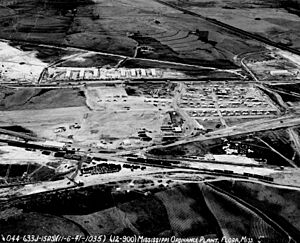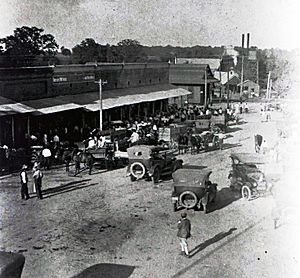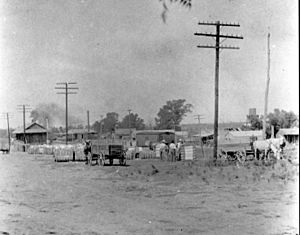Flora, Mississippi facts for kids
Quick facts for kids
Flora, Mississippi
|
|
|---|---|
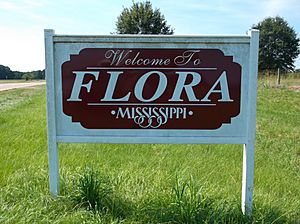 |
|
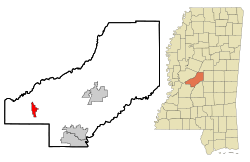
Location in Madison County and the state of Mississippi
|
|
| Country | United States |
| State | Mississippi |
| County | Madison |
| Area | |
| • Total | 3.33 sq mi (8.64 km2) |
| • Land | 3.30 sq mi (8.54 km2) |
| • Water | 0.04 sq mi (0.10 km2) |
| Elevation | 256 ft (78 m) |
| Population
(2020)
|
|
| • Total | 1,647 |
| • Density | 499.70/sq mi (192.94/km2) |
| Time zone | UTC-6 (Central (CST)) |
| • Summer (DST) | UTC-5 (CDT) |
| ZIP code |
39071
|
| Area code(s) | 601 |
| FIPS code | 28-24940 |
| GNIS feature ID | 2406501 |
Flora is a small town in Madison County, Mississippi, United States. In 2020, about 1,647 people lived there. It is part of the larger Jackson area.
The town got its name from Flora Mann Jones, who was one of the first people to live there.
Contents
History of Flora
Flora has a long history, with graves in its cemetery dating back to 1821. A post office opened in 1883. In the same year, Flora became a stop on the new Yazoo and Mississippi Valley Railroad. Today, the old railroad station is a museum. It is also listed on the National Register of Historic Places.
Flora officially became a town in 1886.
Mississippi Ordnance Plant
In 1941, during World War II, a large factory called the Mississippi Ordnance Plant was built north of Flora. This plant made special powders and parts for big guns. It also had areas for testing different weapons like rifles and grenades. A famous science fiction writer, Cyril M. Kornbluth, even worked there.
The company General Tire ran the plant. After the war, in 1945, the government said the plant was no longer needed. They also said the site was clean. However, over time, people realized that the land was still dangerously polluted from the chemicals used there.
One of the strong, reinforced buildings from the plant is now used to store important old records. In 1977, a high school student found an old M-2A2 tank hidden in a wooded area nearby.
National Bio and Agro-Defense Facility
In 2008, the U.S. Department of Homeland Security looked at Flora as a possible place for a new research center. This center, called the National Bio and Agro-Defense Facility, would study dangerous diseases that affect animals and plants. Some people in Flora were worried about the risks of having such a facility nearby.
In the end, another city, Manhattan, Kansas, was chosen for the new facility.
Geography of Flora
Flora is located in the western part of Madison County. U.S. Route 49 runs through the west side of town. This road can take you north about 23 miles (37 km) to Yazoo City or southeast about 20 miles (32 km) to Jackson. Mississippi Highway 22 goes through the middle of Flora. It leads east about 18 miles (29 km) to Canton, which is the main town of Madison County. It also goes southwest about 25 miles (40 km) to Edwards.
Flora covers about 3.3 square miles (8.6 km2) of land. A small part, about 0.04 square miles (0.10 km2), is water. The streams around Flora flow into the Big Black River, which then flows into the Mississippi River.
Just outside Flora, there is a special forest called the Mississippi Petrified Forest. It is full of petrified wood, which means ancient trees have turned into stone over millions of years. It is believed to be the only forest of its kind east of the Mississippi River.
People in Flora
| Historical population | |||
|---|---|---|---|
| Census | Pop. | %± | |
| 1890 | 228 | — | |
| 1900 | 304 | 33.3% | |
| 1910 | 747 | 145.7% | |
| 1920 | 698 | −6.6% | |
| 1930 | 513 | −26.5% | |
| 1940 | 509 | −0.8% | |
| 1950 | 655 | 28.7% | |
| 1960 | 743 | 13.4% | |
| 1970 | 987 | 32.8% | |
| 1980 | 1,507 | 52.7% | |
| 1990 | 1,482 | −1.7% | |
| 2000 | 1,546 | 4.3% | |
| 2010 | 1,886 | 22.0% | |
| 2020 | 1,647 | −12.7% | |
| U.S. Decennial Census | |||
2020 Census Information
| Race | Num. | Perc. |
|---|---|---|
| White | 844 | 51.24% |
| Black or African American | 746 | 45.29% |
| Native American | 7 | 0.43% |
| Asian | 2 | 0.12% |
| Other/Mixed | 35 | 2.13% |
| Hispanic or Latino | 13 | 0.79% |
In 2020, there were 1,647 people living in Flora. There were 652 households and 503 families in the town.
Transportation
The City of New Orleans train, run by Amtrak, travels through Flora. This train goes between New Orleans and Chicago. However, it does not stop in Flora. The closest train station is in Jackson, about 20 miles (32 km) to the south.
Education
The Madison County School District serves the students in Flora. Children in Flora go to East Flora Elementary School. After elementary school, they attend Madison Middle School, Rosa Scott 9th Grade, and then Madison Central High School.
There is also a private school in Flora called Tri-County Academy.
Media
Flora has its own local radio station, WYAB 103.9 FM. There is also a free monthly newspaper called The Flora News.
Notable People
- Maurice Black, a member of the Mississippi House of Representatives
- E. C. Coleman, a professional basketball player
- Parys Haralson, a professional football player
- Paul "Wine" Jones, a blues singer and guitarist
- Belle Kearney, a leader who worked to stop alcohol use and was the first female state senator in Mississippi in 1923
- Cecil Price, a deputy sheriff
Images for kids
See also
 In Spanish: Flora (Misisipi) para niños
In Spanish: Flora (Misisipi) para niños



